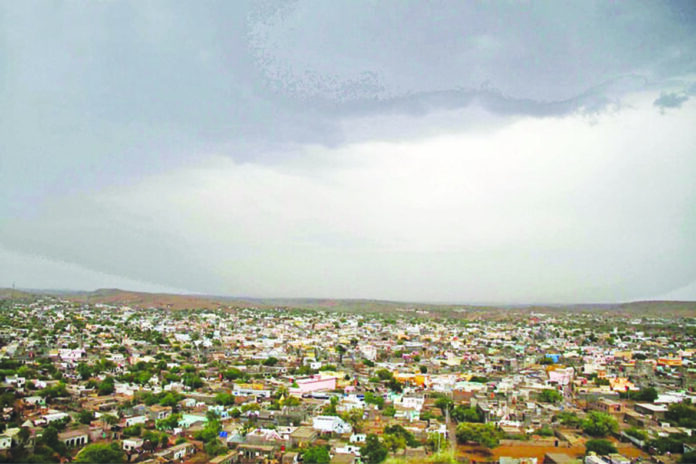Tharparkar, a region once celebrated for its vibrant hues and striking contrasts, now finds itself shrouded in a cloud of fear as lightning strikes devastate lives, livelihoods, and landscapes. Known for its colorful culture and serene desert beauty, Thar was long synonymous with joy and abundance during the monsoon rains. For generations, rainfall signified nature’s blessings, bringing life and food security to the desert.
The romanticism associated with rain has, however, transformed into dread. The rising frequency of lightning incidents has overshadowed the joyous anticipation of the monsoon season, replacing hope with uncertainty and fear. Myths and misinformation surrounding these tragedies exacerbate the anxiety, leaving communities struggling to adapt to this alarming new reality.
Since 2011, the Tharparkar region has witnessed a dramatic surge in lightning-related incidents, leading to an increasing toll of casualties and livestock losses. The lack of preparedness and awareness among communities amplifies their vulnerability, heightening the mental and emotional stress in an already challenging environment. What was once a desert known for its resilience and beauty has now turned into a region plagued by zn exceptionally high number of lightning strikes. According to studies, the Thar region experiences an estimated annual average of 100,000 lightning strikes, significantly higher than the global average of 25,000. This alarming phenomenon can be attributed to the unique environmental, geographical, and climatic conditions of the area, making Tharparkar a compelling focus for scientific research.
The rising incidence of lightning in Tharparkar is closely tied to global climate change. Increasing global temperatures have intensified weather patterns, leading to more frequent and severe thunderstorms. Higher temperatures accelerate evaporation, introducing greater moisture into the atmosphere and fueling powerful storms.
As a result, the frequency and intensity of lightning events in Tharparkar have grown noticeably, creating new challenges for local communities and infrastructure. Additionally, human activities such as deforestation and land degradation further exacerbate the situation. These activities disrupt regional weather patterns and may intensify the severity of thunderstorms, increasing the likelihood of lightning strikes. Understanding these complex interactions is essential for mitigating risks and developing effective interventions.
In response to this growing crisis, the Provincial Disaster Management Authority (PDMA) Sindh, in collaboration with the Fast Rural Development Program (FRDP) and with funding support from WHH, has launched a project to investigate the causes, impacts, and precautions related to lightning in Tharparkar. Primary and secondary data collected during this initiative reveal the devastating toll of lightning incidents over the last five years (2019-2024). In this period alone, 98 human lives were lost, 33 individuals were injured, and 1,756 animals perished due to lightning strikes. These losses underscore the urgent need for effective measures to address the crisis and protect vulnerable communities.
To address this issue, two key consultation workshops were organized— one at the divisional level and another at the provincial level. These workshops brought together stakeholders to discuss the challenges posed by lightning and explore solutions. Participants emphasized the need to enhance public awareness and community outreach through diverse mediums and platforms. Key recommendations emerging from these consultations included:
- Establishing a qualitative and effective Early Warning System at the district level.
- Conducting capacity-building and training programs for Union Council-level cohorts.
- Developing an inter-agency coordination and communication plan with a focus on taluka-level Responsibility Focused Action.
- Strengthening local-level preparedness to ensure effective incident response plans.
By addressing the root causes of the lightning crisis and empowering communities with knowledge and resources, Tharparkar can once again be a land of hope and vitality, where rain is celebrated as a blessing rather than feared as a harbinger of destruction.
The Executive Director of FRDP highlighted the critical role of fostering collaborations and establishing long-term public-private partnerships. He stressed the importance of building resilient communities capable of withstanding the challenges posed by climate change, ensuring a safer and more prosperous future for all.
Mr. Imdad Hussain Siddiqui, Director of Operations at PDMA Sindh, described this joint initiative as a significant step forward. He emphasized the need for an inclusive provincial disaster policy grounded in scientific evidence to address the challenges posed by lightning strikes effectively. He further highlighted that, alongside public education and awareness campaigns, the project includes the installation of communal lightning protection rods in hotspot areas to mitigate risks.
Mr. Babar Ali, Advisor Humanitarian at WHH, elaborated on the importance of localization in humanitarian efforts. He highlighted WHH’s “TOGETHER” initiative, which empowers local humanitarian partners to lead transformative actions. The initiative focuses on localization, timely and accountable assistance aligned with international standards, and capacity strengthening. Implemented in eight countries, its core elements include local leadership, governance, humanitarian capacity building, advocacy, and localization of efforts.
In collaboration with PDMA Sindh, the FRDP team conducted assessments to document safety measures adopted by communities and identify hotspot areas for intervention. Together with an academic partner, they designed awareness sessions and radio messages to educate the general public about lightning safety. Hotspot areas were prioritized for the installation of communal Early Streamer Emission devices as a pilot risk mitigation measure. These devices, based on advanced technology, are intended to provide a higher level of protection against lightning strikes in vulnerable areas.
Saropchand Malhi, a representative of the District Disaster Management Authority, described the urgency of the situation. “We, jointly with stakeholders, are visiting villages like Ikraro, which recorded some 65 lightning incidents in 2024 alone,” he stated. This highlights the immediate need for targeted interventions and sustained efforts to safeguard lives and livelihoods in the region.
The collaboration between PDMA Sindh, FRDP, and WHH represents a multi-faceted approach to tackling the lightning crisis in Tharparkar. By combining scientific research, community engagement, and public-private partnerships, this initiative aims to build a foundation for long-term resilience. The installation of ESE lightning protection devices, coupled with awareness campaigns, early warning systems, and capacity-building programs, offers a comprehensive strategy to mitigate risks and protect vulnerable populations.
As the region grapples with the dual challenges of climate change and inadequate preparedness, initiatives like these are crucial for fostering resilience and ensuring a safer future. Tharparkar’s journey from vibrant colors to clouds of fear underscores the urgent need for innovative solutions, collaborative efforts, and sustained commitment to addressing the impacts of climate change. With the right investments in infrastructure, education, and community preparedness, the region can transform its current challenges into opportunities for growth and resilience.
The story of Tharparkar is a stark reminder of the interconnectedness of climate, human activity, and community resilience. It serves as a call to action for policymakers, researchers, and humanitarian organizations to prioritize inclusive, evidence-based approaches to disaster risk reduction.
We must recognize the rights and responsibilities of all stakeholders and understand that planning solely based on administrative boundaries may not effectively address climate-induced crises. Instead, strategies should consider ecological zones, the capacities of institutions, and the readiness of first responders to manage crises. Emphasizing climate risk financing, promoting insurance, encouraging data sharing, and leveraging collaborative mechanisms, public-private partnerships will collectively enhance resilience and enable more effective anticipatory actions.
By addressing the root causes of the lightning crisis and empowering communities with knowledge and resources, Tharparkar can once again be a land of hope and vitality, where rain is celebrated as a blessing rather than feared as a harbinger of destruction.























